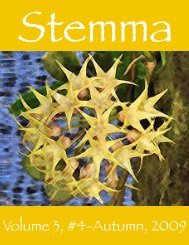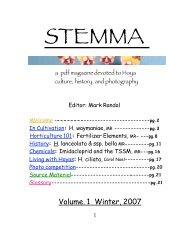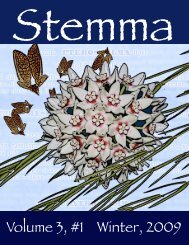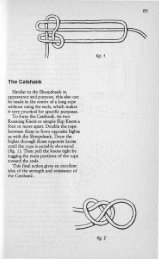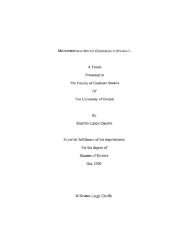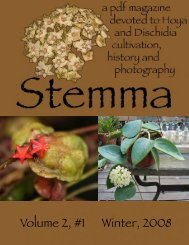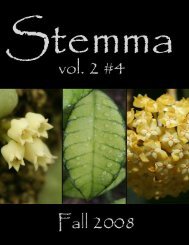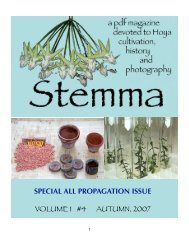Volume 3, Issue #2 - Cubits
Volume 3, Issue #2 - Cubits
Volume 3, Issue #2 - Cubits
Create successful ePaper yourself
Turn your PDF publications into a flip-book with our unique Google optimized e-Paper software.
Taxonomic considerations: The first grouping possibly incorporating a member of this group was R.<br />
Wight’s genus Physostelma (1834), which had as its type species Hoya wallichii. The publication of<br />
Wight’s Physostelma precedes the publication of Hasskarl’s genus Cystidianthus by nine years, and since<br />
both publications are thought by many botanists to deal with morphologically similar species (or possibly<br />
the same species, if H. wallichii is synonymous with H. campanulata, as some sources suggest<br />
[Kloppenburg, 1994]), genus Physostelma has precedence and would be considered the legitimate name<br />
for this grouping. However, Schlechter’s transfer of genus Physostelma into genus Hoya (1914) is rendered<br />
invalid by Art. 53.4 of the ICBN (International Code of Botanical Nomenclature), which states:<br />
“the names of two subdivisions of the same genus, or of two infraspecific taxa within the same species,<br />
even if they are of different rank, are treated as homonyms, the later of which is illegitimate, if they have<br />
the same or a confusingly similar final epithet and are not based on the same type.”<br />
Clearly, the name Physostelma is not able to be transfered into the genus Hoya as a section due to the<br />
previous publication of a section Physostemma Blume (1849), which has Hoya coriacea Blume as its type.<br />
The two names, Physostemma and Physostelma, are more than just similar, they are slightly different<br />
variations of the same greek words “physo” (bladder-like) and “stemma” or “stelma” (crown). The code<br />
prevents duplicate names of this sort in order to prevent the confusion of the taxa involved. Since the<br />
ICBN prevents the transfer of genus Physostelma into genus Hoya as a section, the newer name Cystidianthus<br />
would be the applicable name for this section, unless efforts were undertaken to conserve the<br />
name Physostelma, which would result in the valid inclusion in the infrageneric structure of Hoya the<br />
confusingly similar names Physostelma and Physostemma.<br />
There is a considerable amount of debate over the number of, and proper names for, the species which<br />
seem to belong in section Cystidianthus. Differing sources have the names H. campanulata and H. wallichii<br />
as synonyms or as distinct species, and some botanists believe that the true Hoya wallichii is a very<br />
different plant from the one presented here as H. wallichii so different that it would not belong grouped<br />
with the other campanulate species placed into Cystidianthus with H. campanulata. The plant sold most<br />
commonly as “Hoya cystiantha” is thought to have an invalid name by some sources, and H. phyllura<br />
has not been widely inspected for a consensus to emerge concerning its determination, due largely to its<br />
apparently very demanding cultivation requirements.<br />
Several botanists are working to clarify the standing of this group of species, so changes in species<br />
names or determinations are probable.<br />
14



